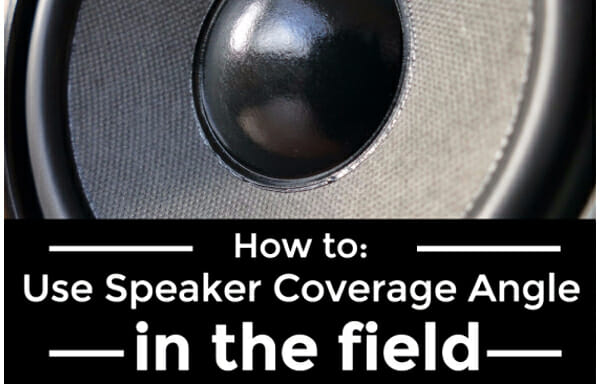Speaker coverage angle is a loudspeaker specification that, when understood, will make you better than 80%* of the other sound engineers out there.
In Sound System: Design and Optimization, Bob McCarthy defines speaker coverage angle as “the angular spread from on-axis (o dB) to the -6dB points on either side.”
Hold on. What’s angular spread? And on-axis? And -6dB points? And why should I care about any of this anyway?*Statistic invented by author.
What’s so important about speaker coverage angle?
By understanding speaker coverage angles, you make the difference between a weak mix with wildly different quality at every point in the room and a strong mix with happy faces in every seat. Having just one or two facts under your belt will help you:
• Design sound systems with more clarity and less money.
• Tune sound systems faster and more effectively.
• Fix problems before they start.
Angular spread
We talk about speakers in terms of horizontal and vertical coverage. For example, a Meyer Sound UPA-1P has a 100° horizontal angular spread and a 40° vertical angular spread. That means that if you lay it on its side, it will sound very different from various locations as you walk around it.
UPA-1P horizontal coverage
UPA-1p vertical coverage
On-Axis
In its simplest form, “on-axis” means “right in front of the speaker”. That’s easy with a simple speaker, but what about speaker boxes that have more than one driver in them, like a UPA-1P? Does on-axis mean right in front of the LF (low-frequency) driver or the HF (high-frequency) driver?
The horizontal on-axis point is easy. It is in the center of the speaker since both HF and LF drivers are vertically aligned in the box.
The vertical on-axis point is where the LF and HF drivers are phase aligned by the manufacturer. This is easy with most speakers from Meyer Sound, for example, because the on-axis point is centered between the HF and LF drivers. One of the reasons they do that is so that you can stack UPA-1P boxes all day long and they will all have the same distance to their neighbor’s on-axis point or acoustic center. For other manufacturers, you’ll have to do some research to find out where the center is.
-6dB (Off-Axis)
To find this point, measure your speaker’s amplitude at 8KHz, then, while maintaining the same distance from the speaker, move your microphone away from on-axis until you measure 6 dB less than where you started. This is your off-axis point for that particular plane.
Looking at Bob McCarthy’s definition again: Speaker coverage angle is the horizontal or vertical distance from the acoustical center of your speaker to where it is 6dB quieter at 8KHz.
Using our UPA-1P example: If the HF driver generates 130dB in your face at 1M, then 50° to the left will measure 124dB in your arm at 1M.
Why 8KHz?
With most speakers, their coverage widens as frequency falls and they are most easily differentiated at high frequencies.
UPA-1P horizontal coverage
UPA-1p vertical coverage
3 easy wins with speaker coverage angle
Right-side up
Do you need more coverage to the sides, or up and down?
Lay our UPA-1P on its side and you’ve got a stage monitor. Now the coverage is horizontally narrow horizontally and vertically wide, allowing performers across the stage to have separate mixes, but if they move upstage they will still be covered.
Less is more
Unless your show demands the power of more speakers, there is no need to overlap coverage angles as long as the entire audience falls within the off-axis points.
Make sound where the people are
Now that you know how important speaker coverage angle is, you can stop wasting precious decibels by blasting them into walls. Point that speaker at people instead! Or figure out how to reposition it for better distribution.
So how do we use speaker coverage angle in the field? That’s what we will cover in Part 2 of this series.
For more on building great sound systems, sign up for Nathan Lively’s free e-course, Intro to Sound System Tuning at Sound Design Live.
